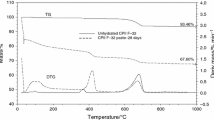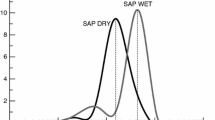Abstract
For Portland cements, Powers’ model provides a simple method for calculating the total amount of water bound by cement hydration (both physically and chemically bound). On the other hand, no such simple model is available for other types of cements that are of increasing interest, such as calcium aluminate cements and calcium sulfoaluminate cements. The main uncertainty for these types of cement regards the amount of physically bound water in the hydrates, while the amount of chemically bound water can be calculated, e.g., by thermodynamic modeling. In this paper, a simple approach for estimating the total amount of bound water of different cements is presented. This novel approach consists in measuring the rate of heat liberation of cement pastes made with the same cement, starting at low water-to-cement ratio (w/c) and increasing it steadily. As the cumulative heat of hydration reaches a plateau for a given w/c and does not increase for further increases in the water amount, this w/c is interpreted as total water demand of the cement. The method is tested with a Portland cement, showing that it is in broad agreement with Powers’ model. First results for calcium aluminate cement and calcium sulfoaluminate cement are presented, from which estimations of the amount of physically and chemically bound water are obtained.







Similar content being viewed by others
References
Powers TC, Brownyard TL. Studies of the physical properties of hardened Portland cement paste. Skokie: Portland Cement Association, Research Laboratories; 1948.
Hansen T. Physical structure of hardened cement paste: a classical approach. Mater Struct. 1986;19(6):423–36.
Baquerizo LG, Matschei T, Scrivener KL, Saeidpour M, Wadsö L. Hydration states of AFm cement phases. Cem Concr Res. 2015;73:143–57.
Baquerizo LG, Matschei T, Scrivener KL. Impact of water activity on the stability of ettringite. Cem Concr Res. 2016;79:31–44.
Lothenbach B, Durdzinski P, de Weerdt K. Thermogravimetric analysis. In: Scrivener K, Snellings R, Lothenbach B, editors. A practical guide to microstructural analysis of cementitious materials. Boca Raton: CRC Press; 2015.
Lam L, Wong YL, Poon CS. Degree of hydration and gel/space ratio of high-volume fly ash/cement systems. Cem Concr Res. 2000;30(5):747–56.
Pichler B, Hellmich C, Eberhardsteiner J, Wasserbauer J, Termkhajornkit P, Barbarulo R, Chanvillard G. Effect of gel–space ratio and microstructure on strength of hydrating cementitious materials: an engineering micromechanics approach. Cem Concr Res. 2013;45:55–68.
Espinosa RM, Franke L. Influence of the age and drying process on pore structure and sorption isotherms of hardened cement paste. Cem Concr Res. 2006;36(10):1969–84.
Cui L, Cahyadi JH. Permeability and pore structure of OPC paste. Cem Concr Res. 2001;31(2):277–82.
Lura P, Jensen OM, van Breugel K. Autogenous shrinkage in high-performance cement paste: an evaluation of basic mechanisms. Cem Concr Res. 2003;33(2):223–32.
Jensen OM, Hansen PF. Water-entrained cement-based materials: I. Principles and theoretical background. Cem Concr Res. 2001;31(4):647–54.
Struble LJ, Brown PW. Heats of dehydration and specific heats of compounds found in concrete and their potential for thermal energy storage. Sol Energy Mater. 1986;14(1):1–12.
Kaufmann J, Winnefeld F, Lothenbach B. Stability of ettringite in calcium sulfoaluminate based cement pastes at elevated temperatures. Adv Cem Res. 2016;28(4):251–61.
Zhang L, Glasser FP. Critical examination of drying damage to cement pastes. Adv Cem Res. 2000;12(2):79–88.
Muller ACA, Scrivener KL, Gajewicz AM, McDonald PJ. Densification of C–S–H Measured by 1H NMR relaxometry. J Phys Chem C. 2012;117(1):403–12.
Justs J, Wyrzykowski M, Winnefeld F, Bajare D, Lura P. Influence of superabsorbent polymers on hydration of cement pastes with low water-to-binder ratio. J Therm Anal Calorim. 2014;115(1):425–32.
Juenger MCG, Winnefeld F, Provis JL, Ideker JH. Advances in alternative cementitious binders. Cem Concr Res. 2011;41(12):1232–43.
Winnefeld F, Barlag S. Calorimetric and thermogravimetric study on the influence of calcium sulfate on the hydration of ye’elimite. J Therm Anal Calorim. 2010;101(3):949–57.
Lura P, Winnefeld F, Klemm S. Simultaneous measurements of heat of hydration and chemical shrinkage on hardening cement pastes. J Therm Anal Calorim. 2010;101(3):925–32.
Xu L, Wang P, Zhang G. Calorimetric study on the influence of calcium sulfate on the hydration of Portland cement–calcium aluminate cement mixtures. J Therm Anal Calorim. 2012;110(2):725–31.
Torréns-Martín D, Fernández-Carrasco L, Blanco-Varela MT. Conduction calorimetric studies of ternary binders based on Portland cement, calcium aluminate cement and calcium sulphate. J Therm Anal Calorim. 2013;114(2):799–807.
Pelletier L, Winnefeld F, Lothenbach B. The ternary system Portland cement–calcium sulphoaluminate clinker–anhydrite: hydration mechanism and mortar properties. Cem Concr Compos. 2010;32(7):497–507.
Winnefeld F, Lothenbach B. Hydration of calcium sulfoaluminate cements—experimental findings and thermodynamic modelling. Cem Concr Res. 2010;40(8):1239–47.
Bizzozero J, Gosselin C, Scrivener KL. Expansion mechanisms in calcium aluminate and sulfoaluminate systems with calcium sulfate. Cem Concr Res. 2014;56:190–202.
Pacewska B, Nowacka M. Studies of conversion progress of calcium aluminate cement hydrates by thermal analysis method. J Therm Anal Calorim. 2014;117(2):653–60.
Le Saout G, Lothenbach B, Taquet, P, Fryda H, Winnefeld F. Hydration of a calcium aluminate cement blended with anhydrite. Adv Cem Res. 2017 (in press).
Chen IA, Hargis CW, Juenger MCG. Understanding expansion in calcium sulfoaluminate–belite cements. Cem Concr Res. 2012;42(1):51–60.
Pelletier-Chaignat L, Winnefeld F, Lothenbach B, Le Saout G, Müller C, Famy C. Influence of the calcium sulphate source on the hydration mechanism of Portland cement–calcium sulphoaluminate clinker–calcium sulphate binders. Cem Concr Compos. 2011;33:551–61.
Le Saoût G, Kocaba V, Scrivener K. Application of the Rietveld method to the analysis of anhydrous cement. Cem Concr Res. 2011;41:133–48.
Le Saout G, Lothenbach B, Hori A, Takayuki H, Winnefeld F. Hydration of Portland cement with additions of calcium sulfoaluminates. Cem Concr Res. 2013;43:81–94.
Götz-Neunhoeffer F. Quantitative phase analysis of various Fe-rich calcium aluminate cement clinkers by selective dissolution and XRPD. In: 11th Int. Congress on the Chemistry of Cement (ICCC2003), July 11–16, 2003, Durban, South Africa (2003).
Snellings R. X-ray powder diffraction applied to cement. In: Scrivener K, Snellings R, Lothenbach B, editors. A practical guide to microstructural analysis of cementitious materials. Boca Raton: CRC Press; 2015.
Kulik DA, Wagner T, Dmytrieva SV, Kosakowski G, Hingerl FF, Chudnenko KV, Berner UR. GEM-Selektor geochemical modeling package: revised algorithm and GEMS3K numerical kernel for coupled simulation codes. Comput Geosci. 2013;17:1–24.
Wagner T, Kulik DA, Hingerl FF, Dmytrieva SV. GEM-Selektor geochemical model-ling package: TSolMod Library and data interface for multicomponent phase models. Can Miner. 2012;50:1173–95.
Hummel W, Berner U, Curti E, Pearson FJ, Thoenen T. Nagra/PSI chemical thermo-dynamic data base 01/01. Radiochim Acta. 2002;90:805–13.
Lothenbach B, Matschei T, Möschner G, Glasser FP. Thermodynamic modelling of the effect of temperature on the hydration and porosity of Portland cement. Cem Concr Res. 2008;38:1–18.
Matschei T, Lothenbach B, Glasser FP. Thermodynamic properties of Portland cement hydrates in the system CaO–Al2O3–SiO2–CaSO4–CaCO3–H2O. Cem Concr Res. 2007;37:1379–410.
Lothenbach B, Pelletier-Chaignat L, Winnefeld F. Stability in the system CaO–Al2O3–H2O. Cem Concr Res. 2012;42:1621–34.
Ivanova AS, Litvak GS, Moroz EM, Kruykova G, Malachov V. The influence of heat-treatment conditions on the dehydration processes of aluminium hydroxide. Izvestiya Sibirskogo Otdeleniya Akademii Nauk SSSR. Seriya Khimicheskike Nauk. 1990;5:62–5.
Acknowledgements
This study was funded by a scholarship from the China Scholarship Council to Mr. Xing Fang and from Empa. Thanks to Mr. Luigi Brunetti for assistance with the measurements and to Dr. Mateusz Wyrzykowski for useful discussion.
Author information
Authors and Affiliations
Corresponding author
Rights and permissions
About this article
Cite this article
Lura, P., Winnefeld, F. & Fang, X. A simple method for determining the total amount of physically and chemically bound water of different cements. J Therm Anal Calorim 130, 653–660 (2017). https://doi.org/10.1007/s10973-017-6513-z
Received:
Accepted:
Published:
Issue Date:
DOI: https://doi.org/10.1007/s10973-017-6513-z




